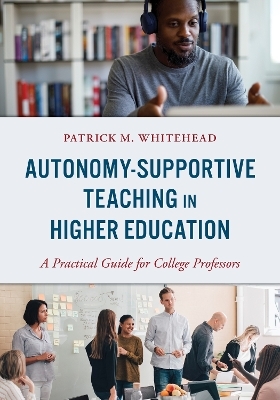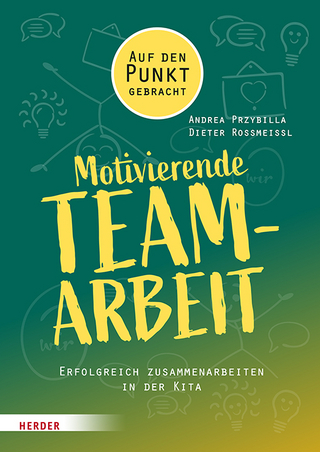
Autonomy-Supportive Teaching in Higher Education
Rowman & Littlefield (Verlag)
978-1-5381-7720-4 (ISBN)
Using ordinary everyday language, Autonomy Supportive Teaching in Higrher Education: A Practical Guide for College Professors organizes and summarizes the mountain of research that has been conducted using autonomy supportive teaching (AST) in the classroom. Hundreds of books, articles, and presentations have been synthesized into a series of chapters and easy-to-follow workshops. By using this book, interested faculty can begin applying the principles of self-determination theory to their classrooms today.
This resource is divided into three sections: 1) AST in Theory, which summarizes the state of the art of motivation psychology in the classroom; 2) AST in Practice, which provides eight workshops where readers are led through dozens of evidence-based and classroom tested strategies for applying AST to their own classrooms; and 3) AST Results, which explores faculty and student reflections on the strengths and weaknesses of AST as it was applied by a group of faculty at an American university.
This book is for college faculty who are tired of student apathy, disinterest, and confrontation, who are interested in helping their students cultivate inner motivational resources. Autonomous learners are interested in more than getting a good grade or doing as they’re told. These are the motivations that increase need satisfaction, lead to lifelong learning, and support a wide variety of independent learning objectives.
Patrick Whitehead is associate professor of psychology and coordinator of general education at Albany State University, where he was named 2019 scholar of the year. He has published six books including Psychologizing: A Personal, Practice-based Approach to Psychology and dozens of articles in the fields of psychology, philosophy, and higher education. He lives on a farm in Albany, Georgia, USA with his wife, Erica.
Acknowledgments
Introduction
Not a Vignette
A Revolution in My Teaching Spirit
AST Will Work for You and Your Students
Three Potential Hurdles: Mistaken Beliefs that Interfere with Professional Development
Mistaken Belief 1: It’s the Students’ Fault
Mistaken Belief 2: Teachers Cannot Change
Mistaken Belief 3: Controlling Teachers Are the Best Teachers
Relation to Other Psychologies of Student Motivation
Grit: Passion and Determination with Angela Duckworth and Cal Newport
Fixed and Growth Mindsets with Carol Dweck
Why We Learn the Ways that We Learn, with Josh Eyler
Structure of this Book
Part I: Theory
Chapter 1: Self-Determination Theory
A Brief History of the Psychology of Student Motivation
Self Determination Theory and the Three Basic Psychological Needs
Autonomy
Competence
Relatedness
Supporting Basic Psychological Needs
Why the Students Wouldn’t Read Macbeth
The Many Forms of Extrinsic Motivation
Continuum of Extrinsic Motivation
Internalization and the Regulation of Beliefs, Values, and Behaviors
No Regulation of Beliefs, Values, and Behaviors
External Regulation of Beliefs, Values, and Behaviors
Externalized Regulation
Introjected Regulation
Internalized Regulation of Beliefs, Values, and Behaviors
Identified Regulation
Integrated Regulation
Intrinsic Regulation of Beliefs, Values, and Behaviors
Chapter 2: Autonomy Supportive Teaching
Vignette 1, Where Online Students Missed the First Deadline
Vignette 2, The One with Lethargic Graduate Students
Autonomy Supportive Teaching
Seven Strategies for Supporting Student Autonomy
Strategy 1: Autonomy Supportive Teachers Adopt their Students’ Perspective
My Experience Taking Students’ Perspective
Strategy 2: Autonomy Supportive Teachers Invite Students to Pursue their Interests
My Experience Inviting Students to Pursue their Interests
Strategy 3: Autonomy Supportive Teachers Present Learning Activities in Need Satisfying Ways
Autonomy
Competence
Relatedness
My Experience Presenting Learning Activities in Need-Satisfying Ways
Strategy 4: Autonomy Supportive Teachers Provide Explanatory Rationale
My Experience Providing Explanatory Rationale
Strategy 5: Autonomy Supportive Teachers Acknowledge Negative Feelings
My Experience Acknowledging Negative Feelings
Strategy 6: Autonomy Supportive Teachers Use Invitational Language
My Experience Using Invitational Language
Strategy 7: Autonomy Supportive Teachers Practice Patience
My Experience Practicing Patience
The Gestalt of Autonomy Supportive Teaching
Chapter 3: Evidence Supporting Autonomy Supportive Teaching in Higher Education
Evidence that AST Works in Higher Education
Physical Education and Other General Education Courses
Remedial Writing Courses
Music and Performing Arts
Psychology and Social Sciences
Sciences and Liberal Arts in South America
Arts and Humanities, Health Sciences, Engineering, and Exercise Sciences in Europe
Online and Asynchronous Courses
Graduate School
Gender Differences in Highly Specific Cases
Intercultural and International Applicability
Conclusion
Part II: Application
Chapter 4: Self-Determination Theory Workshop
Basic Psychological Needs
Regulation of Beliefs, Values, and Behaviors
Chapter 5: Assessing Autonomy Supportive Teaching Workshop
A Preliminary Note on the Difference Between Assessment and Evaluation
Situations in School Inventory
Assessing Structure
Assessing Chaos
Assessing Autonomy Support
Assessing Control
Completing the Inventory and Analyzing the Results
Situations in School Inventory
Scoring
Advanced Scoring
Learning Climate Questionnaire
Classroom Observation Checksheet
Chapter 6: Taking Students’ Perspective Workshop
Methods for Getting Student Feedback
Distribute Slips of Paper Asking for Anonymous Suggestions
Hold an Open “Town Hall” Type Forum
Create a Virtual Survey or Poll
When to Avoid Taking Students’ Perspective
Put It into Practice
Homework Activity #1: Distribute Comment Cards
Homework Activity #2: Seek Candid Reviews of Course Content
Homework Activity #3: Invite Students to Comment on Lesson Plan for the Day
Problems to Expect, and How to Deal with Them
Students Have No Feedback to Share
Students Don’t Seem to Be Interested in Their Own Suggestions
Students Have Only Positive Feedback to Share
Chapter 7: Supporting Students’ Intrinsic Motivation Workshop
AST Strategy Two: Invite Students to Pursue Their Interests
Homework: Identify an Aspect of the Course with Which You Are Comfortable Allowing Students to Participate in Choosing
AST Strategy Three: Present Learning Activities in Need-Satisfying Ways
Competence
Relatedness
Put it Into Practice
Homework Activity #1: Stop and Assess Where Your Students Are
Homework Activity #2: Emphasize Relatedness by Encouraging Students to Work Together
Problems to Expect and How to Deal with Them
Students Have a Range of Skill Levels
Students Are Not Interested in Working Together
Chapter 8: Supporting Students’ Internalization Workshop
AST Strategy Four: Provide Explanatory Rationale
Put it into Practice
Homework Activity #1: Explain Why You’re Doing the Next Thing You Will Be Doing
Homework Activity #2: Integrate Rationale into Assignment Instructions
Homework Activity #3: Explore the TiLT Model of Teaching
AST Strategy Five: Acknowledge Negative Feelings
Homework Activity #1: Acknowledge and Accept the Negative Affect of One Student
Homework Activity #2: Use Collective Negative Affect as a Diagnostic Tool
Homework Activity #3: Reflect on the Ideal Emotional Profile of Students
AST Strategy Six: Rely on Invitational Language
Homework Activity #1: Rewrite Activity Instructions Using Invitational Language
Homework Activity #2: Design an Alternative Assignment
AST Strategy Seven: Practice Patience
Homework Activity #1: Adjust the Amount of Time Needed for Completing an Activity
Homework Activity #2: Patient Listening
Part III: Finishing Touches
Chapter 9: Sample Assessment: Using AST in Online Courses
AST in Online Courses: An Understudied Relationship
Design
Control Condition
AST Condition
List of Sample Activities for AST Condition (Human Growth and Development)
Results
Learning Climate Inventory
Discussion
Additional Results
Student Comments about the AST Condition
Discussion of Assessment Results
Mistake Number 1: Expectations Were Unclear
Mistake Number 2: My Understanding of AST Was Limited
Mistake Number 3: I integrated Too Few AST Strategies
Conclusion
Chapter 10: A Case Study of Teacher Transformation
My 2016 Letter to Students
Course “Deliverables”
Desire2Learn
Be Yourself
My 2022 Analysis of the 2016 Letter to Students
The Letter is Long
The Letter is Formatted Using Headings
There is a Block Quote
The Letter is Not Written from the Students’ Perspective
Students Are Expected to Be Guided by Intrinsic Motivation
There is Little Explanatory Rationale
There is No Room for Affect
It’s My Way or the Highway
Selective Patience
It Isn’t All Bad
A Digital Letter Written to an Online Health Psychology Course in 2022
General Observations
Conclusion: Troubleshooting Problems and Looking Ahead
Some Instructors Will Do This Naturally
Anticipating Problems
The Need for Structure
Logistical Problems with Adopting Autonomy Supportive Teaching
Confusion about What the Strategies Entail
Disagreement about the Teachability of Certain Strategies
External Pressures to Be Controlling
A Call for More Research on AST in Higher Education
AST in Large Lecture Halls (Less than 70 students)
Asynchronous Online Courses
Professional and Organizational Development
References
Index
About the Author
| Erscheinungsdatum | 15.03.2023 |
|---|---|
| Verlagsort | Lanham, MD |
| Sprache | englisch |
| Maße | 181 x 247 mm |
| Gewicht | 381 g |
| Themenwelt | Sozialwissenschaften ► Pädagogik ► Erwachsenenbildung |
| ISBN-10 | 1-5381-7720-X / 153817720X |
| ISBN-13 | 978-1-5381-7720-4 / 9781538177204 |
| Zustand | Neuware |
| Informationen gemäß Produktsicherheitsverordnung (GPSR) | |
| Haben Sie eine Frage zum Produkt? |
aus dem Bereich


